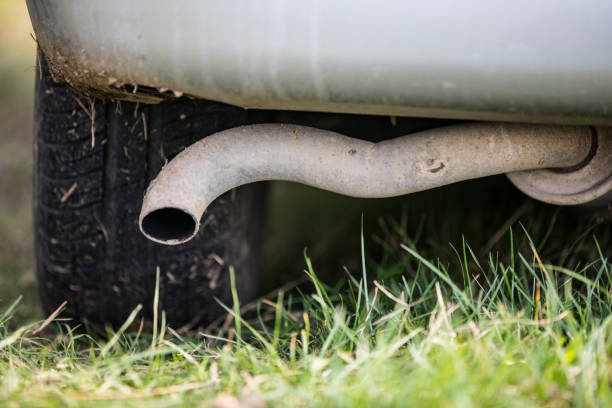Introduction:
Gas leaking out of a lawn mower’s exhaust is an issue that many lawnmower owners face. This doesn’t only affect performance; it also poses safety risks. To have your lawn mower operate safely and efficiently, addressing this problem is vital.
In this detailed guide, we will delve into what causes gas to come out through the muffler of a lawnmower, why fixing it matters, and give a layout of this article to help you easily go through these solutions.
Explanation of the Issue: Gas Coming Out of the Exhaust Lawn Mower
gas leak from a lawnmower’s exhaust system is a common problem that may be caused by engine dysfunction, the wrong fuel mixture rate, or worn-out components, among others.
An engine’s performance is affected by gas leaks from its exhaust system, as well as other safety risks like fire or harmful emissions. A proper identification of this condition calls for good maintenance and troubleshooting services.
The importance of addressing the problem
Gas leakage in the exhaust should not be taken lightly since it can lead to several undesirable outcomes. First, it affects the efficiency as well as the performance of the mower, which results in uneven cuttings and poor engine output. Also, leaking gasoline can lead to hazardous fires and explosions.
This means that excessive gas emissions contribute to environmental pollution. Therefore, the matter has to be addressed immediately to ensure the safety of the operation of the lawn mover and reduce harm to the environment.
Overview:
This piece has been structured in such a way that readers can understand how to deal with issues concerning gas leaking out through their gardening equipment’s tailpipe.
In particular, we shall start by highlighting various reasons why there are leaks before providing recommendations on doing away with them.
On top of that would be preventive measures that could significantly lower any risk for future instances. You have opportunities here where you can follow instructions systematically for resolution, ensuring maximum productivity and a safer environment for your plant.
Understanding the Mechanism
An Explanation of How Lawn Mower Engines Operate:
Lawn mower engines are generally small internal combustion engines that use fuel to convert into mechanical energy for powering the cutting blades on a lawn mower. Essential components of these engines include the fuel tank, carburetor, ignition system, piston, and exhaust system.
Fuel, which is mostly gasoline mixed with oil, is drawn from the fuel tank through the carburetor, where it combines with air in the correct proportions. It then passes to the combustion chamber, where it is ignited through a spark plug, causing a controlled explosion, pushing a piston connected to the crankshaft and consequently running the mower blades.

Causes of Gas Leakage from the Exhaust:
Poor Fuel Mixture: The wrong ratio of air/fuel mixture within the combustion chamber causes incomplete burning, and some unburned fuels can find their way through an exhaust pipe.
Malfunctioning Carburettor: This engine part controls how much fuel-air mix enters the engine. If it fails or is badly adjusted, this can lead to a too-rich mixture of fuel, hence gas leakage through the tailpipe.
Badly damaged gaskets and seals: Over time, the engine’s gaskets and seals may deteriorate, causing the exhaust system to leak gas.
Engine Flooding: Excess fuel entering the combustion chamber is called engine flooding. The latter usually results from a bad choke mechanism or a clogged fuel line. This causes gas to also come out of the exhaust pipe, in addition to other symptoms such as difficulty starting it.
Potential Dangers Associated with Gas Leakage:
Gas leaks coming off a lawnmower’s exhaust have several potential dangers, which include:
- Fire Hazard: Leaking gasoline can ignite easily when near hot engine parts.
- Toxic Fumes: Incomplete burning leads to the release of poisonous gases like carbon monoxide, which can cause poisoning for both humans and animals.
- Environmental Pollution: The emission of gasoline causes air pollution, which is harmful to the environment, especially in confined spaces like garages or storage sheds.
Diagnosis
Step-by-Step Process for Identifying the Source of the Problem:
Here are ways through which you can effectively identify where your gas leakage is coming from on your lawn mower using its exhaust:
Visual Inspection: Commence by visually inspecting whether there are any visible signs of a gas leak around the wet spot or stain or even under the component surrounding this system exhaust.
Check Fuel Mixture: Ensure that you verify that your mixture ratio of fuel within the carburetor falls within a range.
Inspect the carburetor: visibly check for cracks, leaks, etc., and adjust if necessary.
Test Gaskets and Seals: Clothes attention should be given to areas known for leaking when checking these since they get spoiled after some time.
Address Engine Flooding: If there is reason to suspect that there has been flooding of an engine due to gas leakage, then first ensure the choke mechanism has no blockage and also ascertain if the fuel line passes freely.
Common Signs of Gas Leakage from the Exhaust:
Being able to notice the early symptoms of leaking gasoline through the exhaust will help in identifying the issue. These may include:
- Strong Smell of Gasoline: A strong smell of gasoline near the lawn mower, especially around its back part, signifies a possible leak.
- Visible Wet Spots: Wet patches on or beneath metal or metal near its lower surface indicate gas leakage.
- Irregular Engine Performance: If there is a gas leakage, an engine can also run poorly, become weak, or even begin producing black smoke from its rear end.
- Difficulty Starting the Engine: This happens when engine flooding occurs due to leaking fuel.
Tools needed for diagnosis:
The correct diagnosis of gas leakage via lawn mower exhaust requires:
- Flashlight: To give support while visually examining the exhaust and other immediate areas.
- Screwdrivers and wrenches: for unscrewing covers and opening up for inspection of engine parts.
- Carburetor Adjustment Tool: In cases where this is necessary, you will need this appliance.
- Pressure Gauge: For testing for any leaks while checking if there are no gaps in the components making up such systems.
- Fuel Line Clamp: This makes it easier to investigate the carburetor as well as be safe with the fueling system because it will temporarily stop the flow of fuel during repair works.
Follow the above steps and use the required tools to appropriately diagnose your lawnmower’s gas leakage that comes from its exhaust system.
Adjusting the mixture of fuel is an important step to take in dealing with gas leakage from the exhaust of a lawn mower. Here is how to go about it:
- Find where the carburetor adjustment screws are located, usually indicated as “H” (high-speed) and “L” (low-speed).
- Start the engine and wait until it warms up.
- Use a screwdriver to incrementally turn the adjusting screws until the engine runs smoothly without emitting excessive smoke or raw gas from the exhaust.
- Make sure that adjustments are within the manufacturer’s recommendations for this particular modelof lawn mower.
Carburettor Maintenance and Troubleshooting:
Proper maintenance and troubleshooting of a carburetor can help rectify gas leakage-causing problems. These steps include:
- Cleaning: Take out the carburetor and clean it by using a carb cleaner, washing away all dirt, debris, or any varnish built up.
- Inspection: Look out for signs of damage like cracks or leaks; if found, replace any worn-out or damaged component(s).
- Adjustment: The carburetor should be properly adjusted according to manufacturer specifications so that it has the right fuel-air mixture.
Replacing worn-out gaskets or seals:
Worn-out gaskets or seals in your exhaust system could contribute to gas leakage. To do this:
- inspect your exhaust system for any leaks to know where the worn-out gaskets or seals are.
- Remove damaged gaskets and seals, and clean mating surfaces.
- Install new gaskets or seals, ensuring they fit correctly, and make a tight seal, thereby preventing gas leakages.
Techniques for Preventing Engine Flooding:
The following techniques can be used to prevent engine flooding:
- Good Choke Operation: Use the choke mechanism appropriately; only when starting your engine once it is operating well will you see if you need the choke on.
- Fuel Line Maintenance: Periodically check whether there are leaks in your fuel line hose and obstructions to the flow of gas.
- Storage Practices: Drain all the fuel from the tank when planning for long-term storage to prevent bad fuel from causing engine flooding.
Safety Precautions During Repair:
The following safety precautions must be adhered to while repairing an exhaust-leaking lawn mower:
- Disconnect the spark plug wire so as not to have an unintended engine start.
- Work in a well-ventilated area away from gasoline fumes.
- Put on protective gloves and eyewear against possible hazards.
- While handling inflammable substances, watch out and then properly dispose of any waste produced here.
- Thus, by putting into practice these solutions plus safety measures, you will solve your gas leakage problem from your exhaust lawn mower safely, as well as make sure that it works effectively.
Maintenance Tips
Regular Inspection of the Lawn Mower:
Regular inspection of the lawn mower detects potential problems early enough. Important places to check are:
- Exhaust System: Check if there are wet spots or stains around the exhaust system, which indicate gas leakage.
- Fuel System: Inspect that there are no leakages, damages, or clogs within the fuel tank, fuel lines, or carburetor.
- Engine Components: Determine whether engine oil is at the correct level, air filter condition, and spark plug replacement signs.
Conducting these inspections periodically, but preferably before each use, helps in identifying and fixing any problems on time.
Proper storage practices to prevent gas leakage:
Proper storage practices play a fundamental role in preventing gas leakage through the exhaust vents of a lawnmower. Do this:
- Empty the Fuel Tank: When keeping your mower for long periods, empty its fuel tank so that alcohol does not deteriorate inside, leading to leaks.
- Store in a Dry Place: To minimize corrosion, store the lawn mower in a well-ventilated area, such as a garage or shed, where it is less exposed to humidity and moisture.
- Put on a Mower Cover When Not in Use: This helps the machine stay clean from dirt, dust, and even moisture that can damage its engine or cause fuel leakage.
Scheduled Maintenance Checks for the Engine:
For good engine performance and the prevention of gas leakage, scheduled maintenance checks must be done as follows:
- Oil Changes: Replace engine oil regularly as recommended by the manufacturer for proper lubrication, avoiding any damage to the engine.
- Air Filter Replacement: Replace the air filter after some time so that air can flow freely into the engine without being contaminated.
- Spark Plug Inspection: Inspect the spark plug periodically and replace it when it is damaged to keep combustion efficient.
By following a maintenance schedule, you will ensure your lawn mower is in top condition while cutting down on gas leakage risk.
Importance of Using High-Quality Fuel and Oil:
The quality of fuel and oil used greatly affects the performance and longevity of a lawnmower. Here’s why high-quality fuel and oil are essential:
- Engine Performance: Better combustion and lubrication are made possible through the use of high-grade fuel and oil, which help maintain optimal engine performance.
- Reduced Maintenance Costs: The use of these fuels reduces cases of engine problems, minimizing expensive repairs.
- Environmental Impact: High-quality fuels reduce emissions, hence making mowers eco-friendly devices.
You have made an investment worth its weight by spending on good fueling products as you enjoy improved performance, durability, and eco-friendliness for your lawn mower.
Conclusion
In conclusion, this guide outlines how important it is to address gas leaks from your garden equipment’s exhaust system to maintain their efficiency and safety.
By understanding what causes this problem and applying the diagnostic steps provided hereinabove, one gets the opportunity not only to detect the origin of the issue accurately but also to take appropriate measures for rectifying it. In addition, proactive actions like adjusting the fuel mixture, maintaining the carburetor, replacing worn-out gaskets or seals, and performing preventive maintenance will ensure that your lawn mower works optimally.
Additionally, when carrying out any repairs and servicing activities, respect safety precautions to prevent accidents. Always keep your lawn mower in a safe place, as well as check its parts regularly by using proper storage practices, scheduling regular maintenance checks, and using high-quality fuel and oil, thus extending its lifespan while reducing the chances of hazardous gas leakage.
FAQs
What causes gas to come out of the exhaust?
What happens is that when a lawn mower is not stored well, fuel may escape from the tank and enter the exhaust system. This can also occur if you happen to tip off your mower or leave it sideways for a long time.
From there, the fuel evaporates, leaving behind some residue that may block the exhaust system. This will make it possible for gasoline to be released through the muffler when starting your lawn mower.
Why is fuel spitting out of my exhaust?
It’s true that if your lawnmower’s exhaust is ejecting fuel, this could indicate a more serious problem. If there is an imbalance in the engine air-to-fuel ratio, too much fuel can go into the combustion chamber during the combustion process. It could be because of different things, such as a dirty air filter or a worn spark plug, among others.
This issue should therefore be addressed quickly since excessive fuel in your lawn mower’s exhaust system can cause dangerous backfires and possibly even harm its engine.
Why is my 2-stroke engine spitting gas out of the exhaust?
If you are running a 2-stroke engine and notice gas coming from the tailpipe, then this might have something to do with how you mixed up the fuel/oil mixture in the first place. For optimal performance, two-stroke engines require specific quantities of oil and gasoline, respectively, under certain conditions. If one uses the wrong kind of fuel or does not mix them properly, this will lead to excess gasoline entering the exhaust system.
Why is my carburetor spitting out gas on my lawn mower?
One possibility that a carburetor can spit out gas in a lawnmower lies in having unclean air filters. For instance, an obstructed or contaminated air filter may result in less air being provided to an engine, resulting in a rich carburetor and thus excess gasoline pouring through it. Another reason might be due to used plugs, resulting in incomplete combustion and consequently excessive fuel in the exhaust system.
What Causes Lawn Mower Carburettor to Spit Out Fuel?
There are a few potential causes for a lawn mower’s carburetor to spit out fuel. One common issue is dirty or clogged air filters. When the air filter becomes obstructed or contaminated, it restricts airflow to the engine and can cause the carburetor to run too rich, resulting in excess gasoline being forced through.
How can I adjust the fuel mixture to prevent gas leakage?
You should maintain the correct fuel-to-oil ratio in your lawn mower’s engine, which will prevent gas leakage from your carburetor. This is a ratio that may differ depending on the kind of engine or brand; therefore, it is necessary to consult your owner’s manual for this recommended ratio.
Can using high-quality fuel and oil help prevent gas leakage?
Absolutely! High-quality fuels and oils can help in ensuring proper proportionality involving fuel and air within the carburetor, thus avoiding gas leakage. If you make use of low-quality fuels or oils, they might have impurities or additives that tamper with the balance between fuel and air in their carburetor.











Leave a Reply